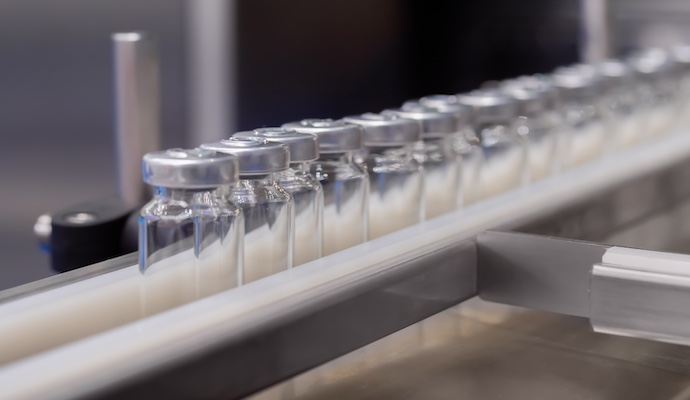Continuous Manufacturing Revolutionizes Pharmaceutical Production
Continuous manufacturing transforms pharmaceutical production, enhancing efficiency and supply chain resilience.

Source: Adobe Stock
- In the pharmaceutical sector, continuous manufacturing (CM) has emerged as a transformative technology with the potential to revolutionize the industry. As drugmakers seek to enhance efficiency, reduce costs, and ensure a resilient supply chain, CM offers a promising solution.
Over the past five decades, pharmaceuticals have predominantly been manufactured through batch manufacturing, which entails a cumbersome, multi-step process utilizing large-scale equipment. Yet, recent strides in manufacturing technology have spurred the pharmaceutical industry to contemplate transitioning from batch manufacturing to the swifter and more efficient CM process.
What Is Pharmaceutical Continuous Manufacturing?
Pharmaceutical continuous manufacturing (PCM) is a cutting-edge approach that enables the production of pharmaceuticals in a continuous, uninterrupted process. Unlike traditional batch manufacturing, which involves multiple steps and locations, CM allows all production stages within a single facility. This streamlined process offers several advantages:
- Increased output
- Enhanced efficiency
- Reduced costs
- Accelerated production
- Greater adaptability in addressing emergencies
"Within the next decade, PCM is poised to become an industry staple alongside traditional batch manufacturing for the production of both innovative and generic pharmaceuticals and biologic products," Bikash Chatterjee, President and Chief Science Officer of pharmaceutical manufacturing consulting services provider Pharmatech Associates, told US Pharmacopeia (USP).
PCM is no different from any other innovation — it brings opportunities and challenges. Obstacles and misperceptions remain, but PCM can potentially transform the industry.
Benefits
CM offers numerous benefits compared to traditional batch processing. These advantages encompass a significant reduction in facility footprint by up to 70% and substantial decreases in operational and running costs by 40–50%. Another strength of PCM lies in its capacity to tackle supply chain challenges, a necessity underscored by the global pharmaceutical manufacturing vulnerabilities exposed during the COVID-19 pandemic.
The technology also enables swift scale-up, facilitates post-approval modifications, and supports larger lot sizes, empowering drug sponsors to promptly address market demands and mitigate shortages. This underscores the imperative for domestic production capabilities, a gap PCM can help fill. By fostering domestic manufacturing expansion, PCM ensures a more dependable supply of vital medications.
Regulatory Considerations
While some manufacturers have expressed concerns about increased regulatory risks associated with PCM, the FDA has conducted studies that demonstrate otherwise. A self-audit comparing continuous manufacturing to batch manufacturing revealed that the former had shorter approval and market times. This finding and the absence of substantial regulatory barriers have encouraged manufacturers to adopt CM as a viable production method.
Certain manufacturers have hesitated to embrace PCM, partly due to perceived heightened regulatory risks. Concerns revolve around potential delays in pre-market approval, heightened inspectional scrutiny, and obstacles encountered post-market, acknowledged Chatterjee, addressing manufacturers' initial reservations.
“However, a recent FDA self-audit comparing PCM to batch manufacturing regulatory outcomes showed manufacturers that submitted PCM applications actually had relatively shorter times to approval and market as compared to similar batch applications, translating to an estimated $171–537M in early revenue benefit," he said.
Industry Adoption
Several pharmaceutical giants, such as Pfizer, Eli Lilly, and GSK, have embraced PCM and achieved commercial success. By implementing CM, these companies have experienced improved efficiency, reduced costs, and enhanced supply chain resilience.
"[These companies] and others have proven PCM's commercial success. Over a half-dozen medicines made using PCM are already approved in the US — an additional handful are available overseas,” Chatterjee highlighted. “Semi-continuous manufacturing is also growing in popularity."
Implications for the Healthcare Industry
CM holds significant implications for the healthcare industry. By improving efficiency and reducing costs, this technology can contribute to the affordability and accessibility of medications. It enables drug makers to respond quickly to market demands, ensuring a stable supply of essential medicines. Additionally, PCM reduces dependence on foreign suppliers, making expanding domestic manufacturing feasible and mitigating the risk of supply chain disruptions.
Standards for quality play a pivotal role in pharmaceutical production and regulation, ensuring the safety, efficacy, and accessibility of medicines, thereby fostering public confidence. This holds true for medications utilizing PCM technology as well. USP standards and associated initiatives have bolstered backing for cutting-edge manufacturing techniques like PCM. These efforts aid stakeholders in establishing clear benchmarks for showcasing process comprehension and quality, expediting the delivery of high-caliber products to the market, thereby enhancing public health on a global scale.
Prospects and Challenges
While CM offers tremendous potential, some challenges need to be addressed. Economic and workforce capacity constraints, upfront investment costs, and regulatory uncertainties in certain regions obstruct widespread adoption. However, solutions are being explored.
Chatterjee proposed the necessity for investments in scientific and technical knowledge development, talent enhancement, and workforce capacity building to address these challenges. He suggested offering incentives like tax credits or grants to encourage companies to adopt continuous manufacturing. Furthermore, Chatterjee emphasized the importance of collaboration among industry, academia, and regulatory agencies to tackle regulatory uncertainties and establish unified standards.
CM represents a paradigm shift in the pharmaceutical industry, offering a more efficient, cost-effective, and resilient approach to drug production. As drugmakers strive for greater supply chain resilience and the ability to meet market demands, PCM emerges as a powerful solution. With ongoing advancements in regulatory frameworks, industry adoption, and support from key stakeholders, CM is poised to become a cornerstone of pharmaceutical production, ensuring a robust supply of quality medicines for patients worldwide.
CM represents more than a technological advancement; it is a transformative force within the pharmaceutical sector. Its potential lies in its ability to enhance the efficiency and dependability of drug manufacturing processes, bolster supply chain robustness, and, most importantly, ensure patients' access to safe, high-quality medications. This innovative approach is poised to redefine the landscape of pharmaceutical manufacturing in the future.
As the healthcare industry evolves, CM promises to drive innovation, improve patient outcomes, and strengthen global health. By embracing this groundbreaking technology, drugmakers can navigate the challenges of the modern pharmaceutical landscape and contribute to a more efficient, resilient, and accessible healthcare system.
